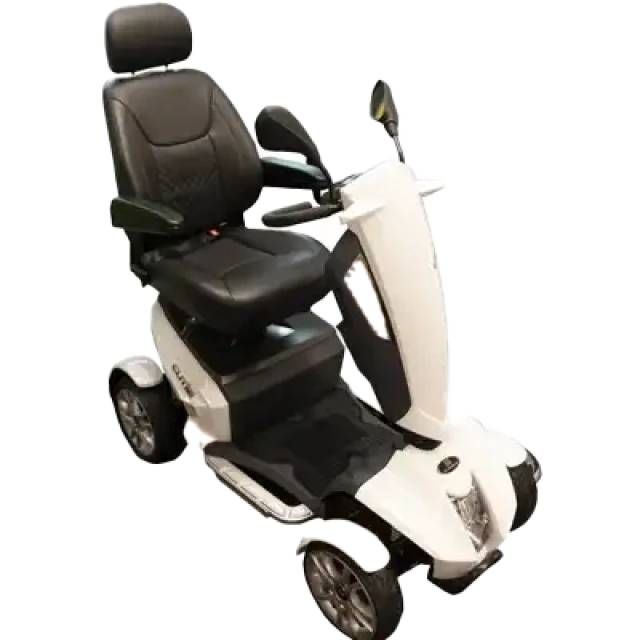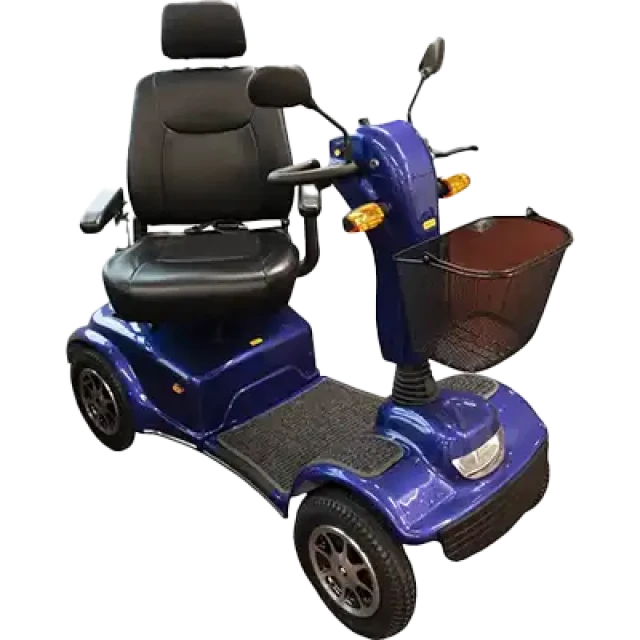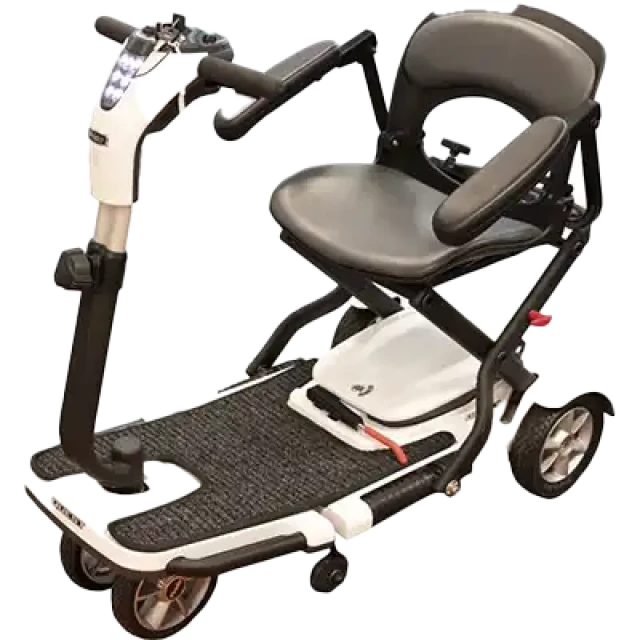Guide to buying a mobility scooter
Find out how to buy a mobility scooter that meets your needs.
On this page
Buying a mobility scooter is a major life decision. You need it to be safe, reliable and functional, providing you with the ability to go wherever you want to. But with so many different types and a huge range of prices, how do you decide which one is right for you?
This guide walks you through the process of figuring that out.
Mobility scooters vs electric wheelchairs
Before you choose a mobility scooter, consider whether it’s the right option for you at all. In some cases, an electric wheelchair could suit your needs better.
Mobility scooters and electric wheelchairs have a lot in common – both are powered by an electric battery and support people who have trouble walking or standing. But they serve different purposes and it’s important you make the right choice.
Electric wheelchairs
Advantages of electric wheelchairs
Electric wheelchairs can be more comfortable to sit in for long periods of time. Some models can accommodate cushions so you can adapt the seat to suit you.
They are also more manoeuvrable than mobility scooters. Electric wheelchairs can be used both indoors and on even terrain outside. Because they are generally much shorter than a scooter, electric wheelchairs are much easier to navigate indoors. If you need help getting around indoors as well as outside, an electric wheelchair could be a good option for you.
Disadvantages of electric wheelchairs
Electric wheelchairs have shorter travel ranges than mobility scooters. The average electric wheelchair can travel up to 20km on a single charge. If you’re out and about for long periods of time this might not be enough.
The heavier weight of an electric wheelchair can also be a drawback. While this can be a good thing for stability, it makes them very difficult to transport.
If you want the freedom to travel over rough terrain, a mobility scooter might be a better option. Most electric wheelchairs are designed to be used on smooth surfaces and they’ll struggle with terrain that’s too hilly or uneven.
If you can walk short distances unassisted and like to live an active lifestyle, a mobility scooter could be a good choice for you.
Mobility scooters
Advantages of mobility scooters
Mobility scooters generally have a longer range than electric wheelchairs. Some can travel 40-60km or more on a single charge. This makes mobility scooters a great choice if you want the freedom to go longer distances.
Many mobility scooters have wider tyres than electric wheelchairs, making them more suitable for travel over difficult terrain. Some even have four-wheel-drive, so they’re ideal if you want the flexibility to go almost anywhere you like.
Disadvantages of mobility scooters
Most mobility scooters are difficult to use indoors due to their large size. They’re not able to get around tight corners as well as many electric wheelchairs can due to their larger turning circle. You can get small scooters that could handle indoor spaces better, but most mobility scooters are designed for outdoor use.
Mobility scooters don’t support the same range of mobility needs electric wheelchairs do. For example, if you use a scooter you need to be able to walk short distances unassisted.
If you think you’d be better off with an electric wheelchair, check out our guide to buying a wheelchair.
Read our guide to buying a wheelchair
Questions to ask yourself when buying a mobility scooter
Buying a mobility scooter is an important and sometimes expensive exercise, so you want to do it right the first time. Answer these questions to help you clarify what your needs are.
How much do you want to spend?
Mobility scooters vary widely in price. Usually, the more features and bigger motor it has, the more it will cost. If you want to buy new, a basic portable mobility scooter can be purchased for around $3,500. Heavy duty scooters can cost upwards of $7,500.
Where will you be using your mobility scooter?
Some mobility scooters can handle driving over rough or steep terrain easily, while others struggle. Do you want the option of riding over uneven ground, or will you be staying mainly on smooth and flat footpaths?
How important is seat comfort?
Some mobility scooters have more comfortable seats than others, so consider this when weighing up your options. Do you want arm rests? How long will you be sitting on your scooter for? How high does the back of the seat need to be? Do you need a longer leg area?
What weight capacity do you need?
Generally, larger mobility scooters have a higher weight capacity. Portable scooters can support a person up to 120kg, a medium scooter can carry someone between 130kg-160kg, and a larger scooter can support people heavier than this.
How far do you need to go?
The size of the battery in your mobility scooter will affect how far you can travel on a single charge. What will you be using your scooter for and how far do you think you’ll need to go on a single charge?
Will your scooter need to be transported?
Some mobility scooters are portable and designed to be transported. Others are too big and heavy to transport easily.
Types of mobility scooters
If you’ve decided to get a mobility scooter you need to narrow down which type will be best for your needs.
Mobility scooters can come in three or four-wheel varieties. While a three-wheeled mobility scooter can be useful for navigating very tight spaces, they are often not recommended because they can tip easily. Most mobility scooters in New Zealand are four-wheeled ones.
Most scooters for sale in New Zealand can be put into one of three categories: medium scooters; heavy duty scooters; and portable travel scooters.
The right one for you will depend on how far you want to travel on your scooter, what kind of terrain you will ride on, and your size requirements.
Medium-sized mobility scooters
If you mainly want to travel short distances on smooth footpaths, a medium-sized mobility scooter could be right for you.
Medium-sized mobility scooters are great for people that don’t need to travel too far. For example, if you just want to pop into town or zip down the road to visit a friend, these medium-sized scooters are ideal.

Scooters of this size can have excellent range, some up to 60km on a single charge. However, most will go 30 – 50km per charge. Most scooters in this range have a maximum speed of 12-15 kilometres per hour.
One of the drawbacks of medium-sized mobility scooters is they generally have smaller tyres than heavy duty scooters. This means they’ll need to stay on relatively smooth terrain. Anything rough or too hilly, and you’ll need to go for a heavy-duty mobility scooter.
These scooters usually have a maximum weight capacity of around 130kg so if you’re heavier you may need to get a heavy-duty scooter.
Heavy-duty mobility scooters
Large mobility scooters are often categorised as heavy-duty and can go almost anywhere, even if the ground is a little rough.
These scooters tend to have larger tyres and wheels, providing a much smoother ride over bumpy terrain. They’re designed to go further and usually have larger motors for increased power when you need it. Most heavy-duty models can travel around 17 kilometres per hour.

Large mobility scooters are often categorised as heavy-duty and can go almost anywhere, even if the ground is a little rough.
These scooters tend to have larger tyres and wheels, providing a much smoother ride over bumpy terrain. They’re designed to go further and usually have larger motors for increased power when you need it. Most heavy-duty models can travel around 17 kilometres per hour.
Heavy-duty scooters are also designed for comfort. They can take much more weight than smaller scooters, usually more than 220kg.
Their large size can make them harder to manoeuvre for smaller people, however, so you’ll want to test drive a few models to see which is the best fit for you.
Portable travel scooters
Portable travel mobility scooters are designed to fold so you can transport them in a vehicle. They’re lighter and easier to stow away or place in the boot of a car, making them ideal for people that don’t need to use a mobility scooter all the time.
While these scooters are lighter than larger mobility scooters, they are still heavy. You’ll need an able-bodied person to lift it or fold it down.

With smaller size comes reduced power and range. Most portable travel scooters have a range limit of around 20km per charge, and their speed will max out at about 6km per hour.
They also have weight capacity limits of no more than 120kg.
Next steps
If you think you know the type of mobility scooter you need, the next step is to test drive some! If you’re not sure where to go, your nearest disability information centre is a good place to start. Many of them sell mobility scooters and will be happy to guide you to the right one for you. If not, they will be able to point you in the right direction.